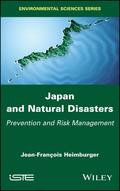Japan and Natural Disasters
Prevention and Risk Management

1. Edition September 2018
228 Pages, Hardcover
Wiley & Sons Ltd
Japan is one of those countries most often affected by powerful natural hazards: earthquakes, tsunamis, volcanic eruptions, typhoons, heavy rains, heavy snowfall, tornadoes, etc. The Archipelago is considered a very advanced country in terms of forecasting, prevention and management of natural disasters. A detailed analysis of the reality of recent years is however necessary. In the run-up to the 2020 Olympic Games in Tokyo, among others, a publication on the subject will inform a large number of people wanting to know more about the risks of natural disasters in Japan.
Part 1 - The hazards
1 Earthquakes
Japan, the main seismic country
B The effects of earthquakes (liquefaction, seismic tsunamis, etc.)
2 Volcanic eruptions
Japan, the main volcanic country
B Volcanic risks
3 Strong winds
A Winds of spring, tornadoes and typhoons
B Wind risks
4 Precipitation
A Heavy rains and the risk of flooding
B Snow and its risks
5 Heat waves
Part 2 - Risk Prevention
1 Forecasting and monitoring
A Short and Long Term Prediction: Success and Limits
B Monitoring (meteorological, seismic, tsunami, boundaries)
2 Alert and evacuation
A Alerts (earthquakes, eruptions, weather phenomena, new system)
B Preventive evacuation
3 Structural measures
A Anti-seismic buildings and dwellings
B Securing critical infrastructure (electricity, gas, water)
C Firefighting (lessons from the Kobe earthquake in 1995, dangers for Tokyo)
D Flood control (submersion, rainfall)
E Resistance of nuclear power plants
4 The soft measures
A The training of the population (hazard maps, preparatory measures, exercises)
B Business formation (business continuity plan)
Part 3 - After impact: from crisis management to reconstruction
1 Crisis Management Tools
A Public authorities and their responsibilities
B Relief
C Companies
2 Evacuation centers
At the first hours
B Life in shelters
C Security in devastated areas
3 Temporary houses
A Construction of temporary housing
B Problems (allocation of temporary homes, long delays, mental health)
4 Recovery
A return to normal life
B Waste Management
C Reconstruction
Part 4 - The benefits of natural hazards
1 Volcanoes
A ash exploitation
B Geothermal energy
2 The benefits from the sky
To the snow
B Water
C The wind
Conclusion


